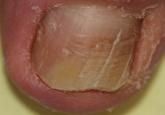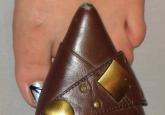Commentary

Onychomycosis: Current and Future Therapies
Onychomycosis, a fungal infection of the nail plate by dermatophytes, yeasts, and nondermatophyte molds, is common in the United States with a...
Ahdi Amer, MD
From the Department of Pediatrics, Children’s Hospital of Michigan, Wayne State University School of Medicine, Detroit.
The author reports no conflict of interest.
Correspondence: Ahdi Amer, MD, Associate Professor of Pediatrics, Wayne State University School of Medicine, 3901 Beaubien Blvd, Detroit, MI 48201 (aamer@med.wayne.edu).

Lichen striatus (LS) is a relatively rare and self-limited linear dermatosis of unknown etiology. It primarily affects children, with more than 50% of cases occurring in patients aged 5 to 15 years. The case of a 2-year-old boy who presented for evaluation of a nonpruritic linear rash on the left side of the lower abdomen of 3 weeks’ duration is discussed. A diagnosis of lichen striatus (LS) was made and the lesions completely resolved within 6 months. At 5 years of age, the patient returned for evaluation of bluish discoloration and thinning of the nails on the left middle and ring fingers, which ultimately fell off and started to regrow 2 months prior to the second evaluation. The rare diagnosis of isolated onychodystrophy as a late manifestation of LS was made.
Practice Points
Lichen striatus (LS) is a relatively rare and self-limited linear dermatosis of unknown etiology. Lichen striatus primarily affects children, with more than 50% of cases occurring in patients aged 5 to 15 years.1,2 It presents clinically as a single unilateral linear band consisting of scaly, 1- to 3-mm papules that coalesce to form long streaks.3,4 The diagnosis usually is made clinically based on the characteristic appearance of skin lesions and a pattern of distribution that follows the lines of Blaschko.5,6 The papules usually are asymptomatic; however, if the patient is symptomatic, pruritus is the most common concern. Lichen striatus may resolve with postinflammatory hyperpigmentation or hypopigmentation that may last for several months to years.
Nail involvement is uncommon in LS; a review of the literature has shown that 30 cases have been reported in the world literature since 1941.7 Nail changes may present before, after, or concurrently with the skin lesions.4,8 On rare occasions, nail involvement may be the only area of involvement without the presence of typical skin lesions.8 The involved nails may show longitudinal ridging, splitting, hyperkeratosis of the nail beds, thinning or thickening of the nail plate, nail pitting, and overcurvature of the nail plate, and rarely the nails may fall off completely.8-10
We report the case of a boy who was diagnosed with isolated LS at 2 years of age. The lesions spontaneously resolved within 6 months. Three years later the patient presented with a rare manifestation of LS in the form of bilateral onychodystrophy.
Case Report
An otherwise healthy 2-year-old boy presented for evaluation of a nonpruritic linear rash on the right lower side of the abdomen of 3 weeks’ duration. A review of systems was negative for any other constitutional signs or symptoms. No sick contacts were reported at the patient’s home, and his immunizations were up-to-date. His medical history was remarkable for a burn on the left hand from contact with a hot object at 11 months of age that required skin grafting.
Dermatologic examination revealed a linear band of small, 1- to 3-mm, flesh-colored lichenoid papules. Many of the papules had a scaly appearance and some had a vesicular component or were flat topped. The band ranged from 2- to 3-cm wide and was 25 cm in length, extending from the right anterolateral part of the lower abdomen to the right upper lateral part of the buttocks (Figure 1). No abnormalities were noted on the rest of the skin. A diagnosis of LS was made.
Figure 1. A linear band of small, 1- to 3-mm, flesh-colored, lichenoid, scaly papules, some with a vesicular component. The band was 2- to 3-cm wide and 25-cm long, extending over the right side of the lower abdomen. Figure 2. Longitudinal ridging, splitting, and thinning of the proximal nail folds on the regrown nails.Figure 3. Bilateral pitting, thinning, and overcurvature of the nail plates of the toenails with more involvement of the toenails on the left foot. |
At 5 years of age, the patient returned for evaluation of bluish discoloration and thinning of the nails of the left middle and ring fingers of several months duration. The patient was afebrile and appeared to be healthy. There was no lymphadenopathy or hepatomegaly and the rest of the physical examination by a pediatrician was unremarkable. The nails of the 2 affected fingers had fallen off 2 months prior to presentation and had started to regrow. On dermatologic examination, it was noted that the regrown nails showed some residual longitudinal ridging, thinning, and dark discoloration of the proximal nail folds (Figure 2). On examination of the other toenails and fingernails there was evidence of bilateral pitting, ridging, and discoloration (Figure 3). The left great toenail was predominantly affected. The patient’s guardians were not aware of the toenail changes and denied any history of trauma to the fingers. When asked about the course of the prior abdominal linear rash, they reported that the lesions had completely resolved within 6 months. The rare diagnosis of isolated onychodystrophy as a late manifestation of the prior LS was made.
Comment
The etiology of LS remains unknown, but there have been several hypotheses suggesting environmental triggers such as trauma11 or infection.12 Others have suggested a possible autoimmune response13 or genetic components.6 Reports of simultaneous occurrences of LS in siblings as well as in a mother and her son14,15; outbreaks of LS among children who are not biologically related but in a shared living environment; and a possible seasonal variation suggest an environmental infectious agent (eg, a virus) as the possible triggering factor. However, laboratory testing for viral etiology in LS has not been helpful.

Onychomycosis, a fungal infection of the nail plate by dermatophytes, yeasts, and nondermatophyte molds, is common in the United States with a...

Fungal melanonychia is an uncommon presentation of onychomycosis. Dermoscopy can assist in the evaluation of nail pigmentation caused by fungi to...

Trauma to the nails can cause and/or exacerbate chronic diseases such as ingrown nails, onycholysis, onychauxis, onychogryposis, and hallux valgus...
